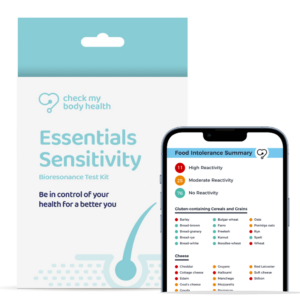
Medically reviewed by Sian Baker, Dip ION mBANT mCNHC
on December 2, 2023. To give you technically accurate, evidence-based information, content published on the Check My Body Health blog is reviewed by credentialed professionals with expertise in medical and bioscience fields.
Signs & Symptoms of a Chocolate Allergy or Intolerance
Chocolate allergies are uncommon, but some people are sensitive to certain components in chocolate. This can cause reactions like upset stomach, skin rashes, or respiratory issues. It’s more likely that discomfort after eating chocolate is due to ingredients like caffeine, theobromine, sugar, or lactose, especially in highly processed chocolates.
We will explain the testing methods for chocolate allergies or intolerances. The prevalence of chocolate intolerance, the potential link between chocolate and heartburn. We will also give you some alternatives to chocolate if you suspect you may have an allergy or intolerance.
Can you be allergic to chocolate?
Yes, some people may indeed experience allergic reactions or intolerance to certain components found in chocolate. Allergies involve the immune system’s response to specific proteins, while intolerances are often related to difficulties in digesting certain substances.
How common is a chocolate allergy?
Chocolate intolerance is less common than other food allergies, but it can still affect some individuals. Factors such as the type of chocolate, its ingredients, and individual sensitivities contribute to the prevalence of chocolate intolerance. It’s essential to differentiate between true intolerance and other factors that may cause discomfort after consuming chocolate.
Signs you may have a chocolate allergy
There are a number of common symptoms you should look out for if you think you may have a chocolate allergy.
- Skin Reactions: Allergic reactions to chocolate can manifest on the skin, resulting in itching, hives, eczema, or redness.
- Digestive Symptoms: Individuals with a chocolate allergy or intolerance may experience digestive issues such as nausea, vomiting, abdominal pain, bloating, or diarrhoea.
- Respiratory Issues: Chocolate allergies can lead to respiratory symptoms, including sneezing, nasal congestion, coughing, wheezing, or shortness of breath.
Individuals with nut allergies should be cautious, especially with milk chocolate or chocolates containing nuts as fillings. Additionally, those with histamine intolerance may experience reactions to chocolate. Histamine is naturally present in cocoa, and those with an impaired ability to break down histamine can experience allergy-like symptoms after consuming chocolate.
Other Factors to Consider
A healthy gut microbiome is also really for proper digestion. An imbalance in gut bacteria can make the body more sensitive to numerous foods, including chocolate. Underlying gut issues or an overgrowth of certain microbes can disrupt how the body handles the various compounds present in chocolate, leading to discomfort even without a true allergy.
Understanding Chocolate Reactions
Not all chocolate is created equal! Understanding the differences in chocolate types can help pinpoint potential sensitivities:
| Chocolate Type | Common Ingredients | Potential Triggers |
|---|---|---|
| Milk Chocolate | Milk solids (lactose), sugar, cocoa butter | Lactose intolerance, sugar sensitivity |
| Dark Chocolate | Cocoa solids, cocoa butter, sugar (less than milk chocolate) | Caffeine sensitivity, theobromine sensitivity |
| Highly Processed Chocolate | Cocoa solids, vegetable oils, sugar, artificial sweeteners, emulsifiers, additives | Sugar sensitivity, intolerances to artificial sweeteners, additives, or other fillers |
Important Notes:
- Cocoa content matters: Higher percentages of cocoa generally mean more caffeine and theobromine.
- Ingredients lists are key: Always check labels, even with familiar brands. Recipes and ingredient sources can change.
- Individual reactions vary: Even within a chocolate type, sensitivities and tolerances differ from person to person.
Why does chocolate hurt my stomach?
The answer is that there are several factors that can contribute to stomach discomfort after eating chocolate. These factors are:
- Caffeine Content: Chocolate contains caffeine, a stimulant that can lead to stomach upset in some individuals, especially those sensitive to caffeine.
- Theobromine Sensitivity: Theobromine, another compound found in chocolate, can also cause stomach discomfort. Some people may be more sensitive to theobromine, experiencing nausea or stomach pain.
- Sugar Content: High sugar content in certain chocolates can contribute to digestive issues, including bloating and discomfort.
Why do I have sudden diarrhoea after eating chocolate?
If you experience sudden diarrhoea after eating chocolate, it could be attributed to various factors:
- Lactose Content
- Artificial Sweeteners
- Caffeine and Theobromine
Does chocolate cause heartburn?
Yes, the relationship between chocolate consumption and heartburn is noteworthy. Chocolate contains substances that may induce relaxation in the lower esophageal sphincter (LES), a muscular structure that separates the stomach from the esophagus. This relaxation can create conditions conducive to the reflux of stomach acid, leading to the sensation commonly known as heartburn.
Why do I have phlegm after eating chocolate?
The presence of phlegm after consuming chocolate may be attributed to several factors. Chocolate contains compounds that can stimulate the production of saliva and mucus in the respiratory and digestive tracts. Additionally, the fat content in chocolate can contribute to a sensation of thickness or coating in the throat.
For some people, an increase in mucus production may be a natural response to certain foods, and chocolate happens to be one of those triggers for some people. It’s important to note that this reaction varies among individuals, and not everyone may experience an elevation in phlegm after consuming chocolate.
How to test for a chocolate allergy?
The good news is that it is possible to test if you’re allergic to chocolate without leaving the comfort of your home.
- Attempt an elimination diet, when you chocolate from your diet to see if your symptoms stop.
- Track what you eat and any symptoms you have in a food diary and see if there’s any crossover.
- Speak to a doctor and talk to them about your symptoms.
- If you suspect you have a chocolate allergy you need to take a food blood allergy test.
Chocolate substitutes and alternatives
If you are attempting an elimination diet or you have confirmed you have a chocolate allergy you’re likely looking for ways to satisfy those sweet cravings.
Here are a few of our favourites:
- Carob: Carob is often used as a chocolate substitute, providing a similar flavour profile without containing caffeine or theobromine.
- White Chocolate: While not a true chocolate, white chocolate is caffeine-free and may be suitable for those with chocolate allergies.
- Fruit-based Desserts: Opt for desserts featuring fruits such as berries, which offer natural sweetness without chocolate.
- Nut Butters: Nut butters, such as almond or peanut butter, can provide a rich and satisfying flavour without the need for chocolate.
References
1. Vitamin D. NIH, Office of Dietary Supplements. URL. Accessed February 15, 2021.
2. Nair R, Maseeh A. Vitamin D: The “sunshine” vitamin. J Pharmacol Pharmacother. 2012;3(2):118-126.
3. Vitamin D2 vs. D3: Which Should I Take for Bone Health?. Cleveland Clinic. URL. Accessed February 15, 2021.
4. Jetty V, Glueck CJ, Wang P, et al. Safety of 50,000-100,000 Units of Vitamin D3/Week in Vitamin D-Deficient, Hypercholesterolemic Patients with Reversible Statin Intolerance. N Am J Med Sci. 2016;8(3):156-162.
5. On call: Vitamin D2 or D3? Harvard Medical School. URL. Accessed February 15, 2021




